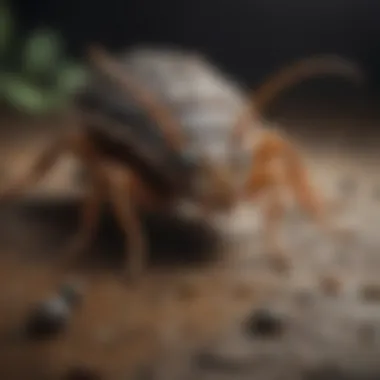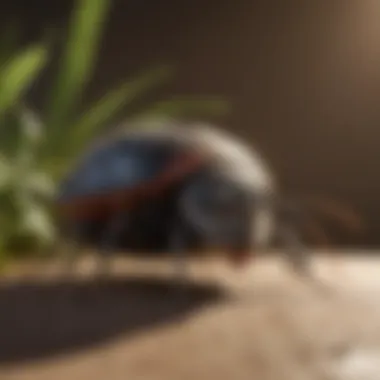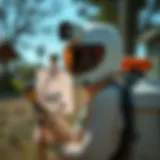Ultimate Pest Control Guide for Victoria


Intro
Pest control in Victoria is an essential consideration for any homeowner. The diverse climate and environment in this region create a variety of habitats for pests, making it crucial to understand how to manage them effectively. This guide provides insights into pest identification, prevention methods, and DIY solutions, aiming to empower individuals with the knowledge necessary to tackle pest-related issues comprehensively.
Understanding the local pest landscape is the first step in addressing potential infestations. It involves recognizing common household pests, their signs, and exploring both preventive measures and control methods. The aim of this guide is to serve as a thorough resource, designed for homeowners who seek to maintain a pest-free living environment. Educating oneself on these topics can lead to more efficient and sustainable pest management strategies.
Understanding the Landscape of Pest Control in Victoria
Pest control is a multifaceted topic. It encompasses various practices and strategies aimed at the management of pests in a way that is both effective and sustainable. In Victoria, where urban and rural settings often collide, understanding the landscape of pest control becomes significant for homeowners.
Preface to Pest Control Practices
Pest control practices involve a mix of prevention, monitoring, and intervention techniques. These practices can vary widely depending on the type of pests, the environmental conditions, and the specific needs of a household. Traditional methods have often relied on chemical treatments, but recent advances advocate for integrated approaches that combine eco-friendly options with technology. This helps in tackling pests efficiently while minimizing harm to the environment.
Moreover, the knowledge of local pest behaviors is crucial. Each season may bring different challenges. For instance, in Victoria, common pests like cockroaches and termites thrive in warm conditions, while rodents become more problematic as colder weather approaches. Homeowners can benefit from understanding these patterns so they can proactively implement control measures.
Importance of Pest Control
The importance of effective pest control cannot be overstated. It contributes significantly to public health, protecting homes from potential disease carriers such as rats and mosquitoes. Furthermore, pests such as termites can cause extensive structural damage if not addressed in a timely manner.
Controlling pests also enhances the quality of life for residents. It allows for a safer and more comfortable living environment. When pest infestations are controlled, families can enjoy their homes without the worry of unwanted intrusions.
"A proactive approach to pest control not only saves money but also protects the health of all residents."
Common Pests in Victoria
Understanding the common pests present in Victoria is vital for effective pest management. The region's unique climate and environment provide a perfect habitat for various pest species. Knowing these pests and their behaviors can help homeowners and residents take proactive measures to reduce the risks they pose. Addressing pest issues early on minimizes potential destruction to properties and helps maintain public health.
Identification of Local Pest Species
Rats
Rats are one of the most common pests in Victoria, significantly impacting both homes and businesses. Their key characteristic is their remarkable adaptability, allowing them to thrive in various environments. Rats can reproduce quickly, which contributes to their status as a prevalent concern. A unique feature of rats is their keen sense of smell, which they use to locate food sources. This attribute makes them persistent foragers. A disadvantage of having rats in a property is the potential spread of disease, as they can contaminate food and create unsanitary conditions.
Cockroaches
Cockroaches are another widespread pest found throughout Victoria. Their key characteristic includes their resilience to many forms of pest control, making them particularly hardy pests. They thrive in warm and moist environments, which are often found indoors. Cockroaches can reproduce rapidly, leading to infestations that can be difficult to manage. Their unique feature is their ability to survive on minimal food sources, which helps them persist even in challenging conditions. The disadvantage lies in their tendency to carry harmful bacteria, leading to health risks for households.
Termites
Termites pose a significant threat to structures in Victoria, particularly wooden buildings. Their key characteristic is their ability to consume cellulose, a major component of wood, which allows them to damage properties unseen. Termites work collaboratively in colonies, leading to efficient destruction of timber. A unique feature of termites is their role in the ecosystem, as they contribute to decomposition in nature. However, this advantage turns into a disadvantage when they invade homes, causing extensive damage before they are discovered.
Behavioral Patterns of Common Pests
Feeding Habits
Feeding habits of pests like rats, cockroaches, and termites considerably influence their management. The importance of understanding these habits lies in knowing which food sources attract them. For instance, rats are opportunistic feeders, consuming anything from grains to garbage. Cockroaches often feed on scraps and even paper products. Termites specifically seek out wood and plant materials. Their unique feature here is the capability to exploit diverse resources. This aspect is beneficial for pest management; knowing their diets can help identify potential entry points or attractants in one's home.
Breeding Patterns
Each pest's breeding patterns play a critical role in their population dynamics. Understanding these patterns provides insights into when they are most likely to invade or cause problems. Rats can produce multiple litters in a year, with each litter containing several young. Cockroaches have similar traits, with females often carrying egg cases until they are ready to hatch. Termites also showcase rapid reproduction within colonies. A significant advantage is recognizing these breeding cycles can inform suitable times for preventative measures, such as baiting or sealing entry points.
Seasonal Activity
Pests in Victoria display distinct seasonal activity levels influenced by environmental changes. The significance of seasonal behavior is that it can affect the timing of pest control measures. For example, many infestations increase during warmer months when food is abundant. Rats often seek shelter in colder months, while cockroaches become more active as temperatures rise. Termites follow a similar trend, emerging more frequently in spring. Understanding these seasonal activities aids homeowners in strategically implementing pest control methods.
Understanding common pests and their behaviors is essential in developing effective pest management strategies.
Legislation and Regulatory Framework
Understanding the legislation and regulatory framework surrounding pest control in Victoria is crucial for both homeowners and pest management professionals. This framework ensures that pest control methods are effective while also being safe for the environment and public health. Compliance with regulations not only enhances the effectiveness of pest management techniques but also minimizes potential risks associated with improper pest control practices.
In Victoria, various laws and guidelines govern pest management. These regulations outline what substances can be used, the proper training required for professionals, and the necessity of maintaining public safety and environmental quality. Knowing this framework helps individuals make informed decisions about pest control strategies and understand the legal implications of their actions, especially concerning chemical usage.
Overview of Pest Control Regulations in Victoria
Pest control regulations in Victoria are designed to protect the environment and public health. They cover a range of topics, including the use of pesticides, proper application techniques, and the registration of pest control substances. The Victorian Government, through the Department of Health, has established guidelines that dictate how pest control should be carried out. This greatly impacts residential pest control practices.
Some of the key points are:
- Pesticide Use: Only registered pesticides can be utilized in pest control, ensuring they have been tested for safety and effectiveness.
- Application Methods: Regulations require specific application methods to minimize exposure risks. For example, certain pesticides must be applied in conditions that do not endanger humans, animals, or the environment.
- Record Keeping: Pest control professionals must maintain detailed records of treatments, including the substances used, locations treated, and any incidents occurred.


Adhering to these regulations not only ensures compliance but also builds trust with the clients who prioritize safe and effective pest management.
Licensing Requirements for Pest Control Professionals
Licensing for pest control professionals in Victoria serves to ensure that only qualified individuals are engaged in pest management. Licensing requirements include completing specific training courses and having knowledge of pest species, chemical safety, and application methods.
To obtain a license, applicants must usually meet the following criteria:
- Training Courses: Successful completion of recognized training courses focused on pest management techniques and regulations.
- Practical Experience: A certain amount of hands-on training or experience under the supervision of a licensed pest controller.
- Written Examination: Candidates may need to pass an exam that assesses their knowledge about pest control practices and regulations.
These licensing requirements are not merely bureaucratic hurdles; they are in place to safeguard both the practitioners and the public. By ensuring that pest controllers possess the necessary skills and knowledge, Victoria can reduce the likelihood of harm resulting from ineffective or unsafe pest control methods.
Regulatory compliance plays a key role in effective pest management, and adherence to licensing standards enhances the professionalism of the pest control industry.
Overall, understanding and navigating the legal landscape of pest control in Victoria is essential for homeowners and professionals alike. By staying informed about regulations and licensing requirements, one can effectively manage pest issues while adhering to safety and environmental standards.
Pest Prevention Techniques
Pest prevention is a crucial aspect of managing pest-related challenges in Victoria. Effective prevention techniques can significantly reduce the likelihood of infestations, saving homeowners from potential damages and costly pest control services. Understanding these techniques allows individuals to create a less hospitable environment for pests, enhancing overall home hygiene and safety.
Creating an Uninviting Environment
Creating an uninviting environment for pests involves several strategies that contribute to a less conducive living area. Implementing these strategies can deter various pest species from making your home their own.
Proper Waste Management
Proper waste management stands as a foundational element in pest prevention. Maintaining clean and organized waste disposal reduces the attraction for pests. The key characteristic of proper waste management is the regular and correct disposal of trash, compost, and recyclables. By doing this, one minimizes potential food sources for pests. This method is a beneficial choice for keeping homes pest-free, as it is relatively easy to implement and does not require any special skills.
The unique feature of effective waste management lies in routine practices such as using tightly sealed bins and ensuring prompt removal of waste. Its advantage lies in the prevention of infestations, whereas a potential disadvantage is that failure to maintain consistent waste management can lead to increased pest activity.
Sealing Entry Points
Sealing entry points is an important measure in pest prevention. Pests often enter homes through small cracks and openings. The key characteristic of sealing entry points is its focus on eliminating access points for pests. This tactic is considered a popular choice among homeowners because it directly addresses the root cause of pest infiltration.
A unique feature of this method is the versatility in materials used, such as caulk or weather stripping, to effectively block entry points. The advantage is the long-lasting effect it has in keeping pests out. However, a potential disadvantage could be the initial time and effort required to identify and seal all possible entryways.
Landscaping Tips
Landscaping tips play a significant role in pest prevention as well. The key characteristic is the enhancement of property tounderstandable low-pest-attraction areas. By managing how greenery is arranged, homeowners can create barriers for pests. This is a beneficial choice as it employs natural aesthetics to improve pest control strategies and overall curb appeal.
A unique feature of landscaping in pest prevention includes planting certain pest-repelling plants. This complements pest management efforts by using nature to deter unwanted visitors. The advantage is a dual benefit of beauty and functionality. However, the disadvantage may include the need for ongoing maintenance and knowledge about which plants provide the best pest deterrence.
Implementing Routine Maintenance
Routine maintenance serves as a proactive approach in pest prevention. It ensures that potential pest problems are addressed before they escalate. Regular checks and timely interventions play a significant role in maintaining a pest-free environment.
Regular Inspections
Regular inspections are vital in identifying pest issues early on. The key characteristic of this practice is the systematic approach to check for signs of pests throughout the home. It is a beneficial choice as it allows for early detection and control of infestations, which can prevent larger problems in the future.
The unique feature of regular inspections is their scheduled frequency, which can vary based on the season or past pest experiences. The advantage is that early identification can lead to simpler management solutions. On the downside, it may require time and effort to conduct thorough inspections regularly.
Home Repairs
Home repairs are another essential aspect of routine maintenance. This involves fixing structural issues that could serve as entry points for pests. The key characteristic of home repairs is ensuring that everything from window screens to doors is in optimal condition. This is a beneficial choice because it not only aids in pest control but also enhances the overall integrity of the home.
A unique feature of home repairs is the immediate impact on pest prevention once repairs are completed. The advantage is a safer environment, while the disadvantage could be the associated costs or effort involved in maintaining home structures.
Seasonal Preparations
Seasonal preparations are crucial for pest prevention trends. Different pests emerge at various times of the year, necessitating specific preventive measures. The key characteristic of seasonal preparations is their adaptability based on climatic changes and pest behavior. This is a beneficial choice since tailored approaches can effectively address seasonal pest issues.
The unique feature of this practice lies in its proactive nature, allowing homeowners to adjust their strategies based on forecasts and patterns. The advantage is a targeted response to potential infestations aligned with seasonal changes, while the disadvantage can be the need for ongoing education about pest cycles.
DIY Pest Control Solutions
DIY pest control solutions offer homeowners a practical method to manage pest issues while often being more accessible and cost-effective than hiring professional services. Engaging in these self-directed methods empowers individuals to take immediate action against pests, possibly reducing anxiety associated with infestations. However, it is essential to consider safety and effectiveness, as improper techniques can sometimes exacerbate the problem.
Eco-Friendly DIY Techniques
Natural Repellents


Natural repellents serve as a viable alternative to chemical pesticides, allowing homeowners to manage pests without introducing toxic substances into their environment. One of the key characteristics of natural repellents is their non-toxic nature, making them safer for children and pets. Common examples include vinegar, cedar oil, and garlic spray.
These repellents work by emitting scents that deter pests, thus reducing the likelihood of infestations. An advantage of using natural repellents is that they are often easy and inexpensive to make at home. However, a disadvantage is that they may require more frequent application compared to synthetic options, and their effectiveness can vary.
Traps and Baits
Traps and baits provide a direct method for controlling pest populations. A significant characteristic of this approach is its ability to target specific pests, minimizing harm to non-target species. There are various types of traps, such as glue traps for insects and snap traps for rodents, providing different methods tailored to diverse pest types.
The unique feature of traps and baits is their passive nature; once set, they require little monitoring. One of the key advantages is the potential for substantial pest reduction. However, the downside could include the possibility of a trapped animal causing distress, especially in the case of pets.
Essential Oils
Essential oils have gained popularity as a versatile tool in DIY pest control. A primary characteristic of essential oils is their aromatic compounds, which can repel various pests while also enhancing indoor air quality. Oils like peppermint, tea tree, and lavender are commonly used for such purposes.
One distinctive feature of essential oils is their dual purpose; they can act as natural pest deterrents while also providing pleasant scents. This characteristic makes them a beneficial choice for households wanting to maintain a pleasant environment. However, certain essential oils may cause allergic reactions, and their potency may not be as strong as that of commercial pesticides.
When to Consider Professional Help
While DIY methods can be effective, there are situations that warrant professional pest control services. If an infestation persists despite your best efforts, or if the pests pose significant health risks, it is advisable to seek expert assistance. A professional assessment can provide tailored solutions and ensure that the underlying causes of infestations are comprehensively addressed.
Professional Pest Control Services in Victoria
Professional pest control services play a vital role in effectively managing pest-related issues in Victoria. Homeowners, especially those with persistent infestations, often seek expert assistance to ensure their homes are free from pests. Utilizing professionals offers numerous benefits, including targeted treatment, specialized knowledge, and compliance with regulations. These services not only focus on immediate removal but also on prevention strategies tailored to the local ecosystem.
Evaluating Pest Control Companies
When considering pest control professionals, evaluating their companies is essential. This evaluation can empower homeowners to make informed choices and ensure effective treatments.
Criteria for Selection
The criteria for selecting pest control companies should include several key aspects. First, experience matters. Companies with a solid track record tend to understand local pests better and can address infestations more effectively. Second, licensing is crucial. A licensed company complies with local regulations and is recognized by the authorities. Lastly, consider methodologies used. Eco-friendly methods may appeal to those concerned about environmental impact. This ensures a comprehensive approach to pest management that aligns with your values.
Unique features of selection criteria include understanding the diversity of available treatment options—ranging from chemical to natural treatments. This flexibility allows homeowners to choose the best approach according to their preferences and the specific pest issue.
Reputation and Reviews
Reputation and customer reviews play a significant role in evaluating a pest control company. A company's standing in the community often reflects its quality of service and effectiveness. Positive reviews indicate reliability, consistency, and successful pest management. Conversely, negative feedback serves as a valuable warning for potential customers.
A major characteristic of reputation is the recommendations from previous customers. Word of mouth can be incredibly powerful. Additionally, many people turn to online platforms to share their experiences, influencing the choices of others. Evaluating the feedback allows homeowners to discern which companies can translate their claims into real results.
However, one potential disadvantage is that some reviews may be biased. It’s essential for homeowners to weigh numerous opinions to gain a balanced view.
Understanding Service Agreements
Understanding service agreements is vital for setting clear expectations between homeowners and pest control companies. A well-defined agreement outlines the scope of work, treatment plans, and payment structures. This clarity can prevent misunderstandings later on.
Factors in service agreements may include:
- Frequency of treatments: Specifies how often the company will conduct inspections and treatments.
- Duration of the contract: Indicates the period the agreement covers and any renewal terms.
- Warranties and guarantees: Explains what results homeowners can expect and any remedies if the service does not meet the standards set in the agreement.
Understanding these agreements helps mitigate risks and ensures that homeowners receive the care and attention necessary to manage pest issues effectively.
Sustainable Pest Management Practices
Sustainable pest management practices are crucial in modern pest control strategies. These methods focus on long-term prevention and solutions that minimize harm to the environment, humans, and non-target species. By emphasizing eco-friendly approaches, these practices help in maintaining ecological balance while effectively managing pest populations.
Principles of Integrated Pest Management
Integrated Pest Management, or IPM, is a staple of sustainable pest control. The principles of IPM include the following elements:
- Monitoring: Routine checks and monitoring help identify pest infestations before they become severe. Understanding the life cycle and behavior of pests can inform appropriate interventions.
- Prevention: Preventive measures such as sealing entry points and managing waste are fundamental. By limiting access, pests can be deterred more effectively.
- Threshold Levels: IPM uses established economic or aesthetic threshold levels to decide when control measures are needed. Not all pests require immediate action, and understanding this helps prioritize responses.
- Control Measures: A diverse set of control techniques is employed, ranging from biological controls like beneficial insects, to mechanical methods like traps. Chemical controls are used judiciously and only when necessary, targeting specific pests to reduce impact on the environment.
Adopting IPM not only addresses pest issues but also educates homeowners on a holistic approach to gaps in preventive measures.
Promoting Biodiversity as a Control Measure
Biodiversity plays a critical role in sustainable pest management. Enhancing biodiversity can lead to natural pest control mechanisms. This approach is based on the principle that a diverse ecosystem will naturally regulate pest populations. Key practices include:
- Native Plant Species: Planting native species attracts beneficial insects and creates a balanced ecosystem. These plants provide habitats and food sources for predatory species that feed on pests.
- Companion Planting: Certain plants can deter pests when grown together. For example, marigolds are known to repel nematodes and other harmful insects in gardens.
- Creating Habitats: Establishing natural habitats in outdoor spaces, such as brush piles or wildflower gardens, encourages predatory species like birds and bats to inhabit residential regions. These species help control pest populations naturally.
"Sustainable pest management not only treats the problem at hand but fosters a balance that seeks to prevent future infestations."


Emphasizing biodiversity within pest control strategies is not only a practical approach but also an environmentally responsible one. It allows us to work in harmony with nature rather than against it.
Analyzing Pest Control Costs
Understanding pest control costs is crucial for homeowners in Victoria. It helps them make informed decisions regarding pest management strategies. When faced with an infestation, budget considerations can influence the choice between DIY pest control or hiring professionals. Knowing the costs associated with pest control not only reduces stress but also aids in planning financial resources effectively. Assessing what contributes to pest control expenses provides clarity and insight into effective solutions.
Factors Influencing Pest Control Costs
Type of Pest
The type of pest involved plays a significant role in determining pest control costs. Different pests require distinct approaches for treatment. For instance, rodents may necessitate specialized traps and baits while termites often demand extensive treatment plans, including wood replacement. The complexity of managing various pest species can affect pricing substantially.
Certain pests are notorious for causing damage, which can influence the urgency and methods of control used. More destructive pests typically require immediate action. Consequently, the costs can soar as urgency is a factor. Some people find it beneficial to understand common pests in their area so they can prepare their budget accordingly.
Severity of Infestation
The severity of infestation is another critical factor. A minor pest problem will generally be less costly to treat than a major infestation. For instance, a few ants in the kitchen may only require a simple bait, while a full colony invading the home can call for comprehensive treatment.
The urgency connected to severity is also impactful. A more serious issue may require multiple visits from professionals, increasing overall costs. Many homeowners recognize that tackling infestations early can save them money in the long run, making preventive measures worthwhile.
Treatment Duration
Treatment duration is the final factor influencing pest control costs. The length of time needed to resolve a pest issue can vary tremendously based on the pest type and severity of the infestation. Some treatments may require one-time solutions, while others drag on over several weeks or months.
Moreover, prolonged treatment plans typically mean additional costs for ongoing inspections and follow-up visits. Homeowners should analyze the benefits of different treatment durations. This diligence can lead to better budget management. Individuals often find that understanding treatment timelines is essential for making informed choices about pest control.
Cost Comparison of DIY vs. Professional Services
When comparing costs, DIY pest control solutions often appear more economically viable. Homeowners may invest in natural repellents, traps, and sprays available in local stores. However, the effectiveness of these solutions varies considerably.
On the other hand, professional pest control services usually come with higher initial costs. However, they bring expertise and thoroughness that DIY methods may lack. Understanding both options is vital for making sound financial decisions. Factors such as the pest type, severity of the problem, and required treatment duration should weigh heavily in this comparison.
Future Trends in Pest Control
Understanding the future trends in pest control is essential for anyone involved in managing pest-related issues in Victoria. As pest control evolves, integrating new technologies and adapting to environmental changes become key components. Recognizing these trends enables homeowners and professionals to employ more effective strategies, ultimately leading to better pest management outcomes.
Technological Innovations in Pest Management
The rise of technology has fundamentally shifted pest management practices. Innovations such as smart traps, remote monitoring systems, and data analytics tools are noteworthy advancements. Smart traps, for instance, utilize sensors to detect and capture pests, significantly reducing the need for toxic bait. Remote monitoring systems allow pest control professionals to track rodent movements and infestations in real time. This can result in timely interventions, lowering the risk of larger infestations.
Additionally, mobile applications are changing how users monitor and report pest activity. These applications can provide real-time data and alerts, making it easier for homeowners to stay informed. Coupling these technologies with traditional methods creates a more comprehensive approach to pest management.
- Improved Efficiency: Technological solutions help in reducing labor and chemical use, leading to more efficient pest management.
- Data-Driven Decisions: Access to data allows for better decision-making based on actual pest behavior, improving treatment success rates.
- Custom Solutions: Technology permits customized treatment options, targeting the specific needs of a household or property.
"Integrating technology in pest management paves the way for more sustainable and effective strategies that benefit both homeowners and pest control professionals."
The Role of Climate Change on Pest Populations
Climate change is an increasingly pertinent factor in pest management. Fluctuating temperatures and changing weather patterns affect pest behavior, reproduction rates, and survival. For instance, warmer winters can lead to longer active seasons for pests like cockroaches and termites, increasing their populations.
This shift necessitates adjustments in pest control strategies. Homeowners may need to ensure their prevention measures are adaptable to these climatic changes. Monitoring pest populations and adjusting treatments accordingly can also prove beneficial.
- Increased Awareness: Homeowners must stay informed about which pests are becoming more prevalent due to climate change.
- Ecosystem Impact: Changes in pest populations can also influence local ecosystems, potentially leading to a rise in other pest species.
- Proactive Strategies: Anticipating pest activity based on climate predictions can help in formulating effective prevention techniques.
In summary, staying ahead of technological advances and understanding the implications of climate change on pest behavior are critical for effective pest control in Victoria. These trends emphasize the need for continuous learning and adaptation in pest management practices.
End on Pest Control in Victoria
Pest control in Victoria is an essential part of maintaining both residential and commercial environments. The issues resulting from pest infestations can lead to severe health risks, structural damage, and considerable financial loss. Understanding the strategies available for effective pest management allows homeowners to make informed choices. This conclusion encapsulates the salient points discussed above, emphasizing not just the methods available, but also the rationale behind them.
Effective pest control practices do not merely eradicate existing issues; they incorporate a comprehensive approach that includes prevention, monitoring, and intervention. By fostering a deeper understanding of pest behavior and lifecycle, individuals can anticipate and mitigate infestations before they escalate.
Moreover, a focus on sustainable practices aligns pest control strategies with ecological responsibility. This includes utilizing eco-friendly solutions and promoting biodiversity, which are becoming increasingly vital in the management of pest populations. In consideration of the evolving environmental challenges, particularly those related to climate change, adaptive management strategies can fortify resilience against pest-related adversities.
"A proactive stance in pest control not only safeguards property but also ensures a healthier living environment for all."
Summary of Key Points
In reviewing the entirety of the article, several key themes emerged:
- Pest Identification: Recognizing the types of pests prevalent in Victoria and understanding their unique behaviors.
- Prevention is Key: Focusing on proactive measures such as proper waste management, sealing entry points, and regular maintenance.
- DIY vs. Professional Help: Weighing the benefits of eco-friendly DIY solutions against the efficacy and expertise offered by professional services.
- Regulatory Awareness: Navigating the legal frameworks surrounding pest control, including understanding licensing requirements.
- Sustainable Practices: Emphasizing integrated pest management techniques and their role in promoting biodiversity.
Final Recommendations
Based on the insights presented, several recommendations can enhance pest control efforts:
- Educate Yourself: Homeowners should familiarize themselves with the common pests in their area and their specific behaviors to tailor their pest control approach effectively.
- Routine Maintenance: Implement regular home inspections and seasonal preparations to prevent pest infestations proactively.
- Sustainable Choices: Opt for eco-friendly pest control methods, such as natural repellents and traps, to minimize environmental impact.
- Professional Consultation: Engage with certified pest control professionals for guidance, especially when dealing with severe infestations or structural concerns.
- Stay Informed: Remain updated on local pest control regulations, ensuring compliance while also benefiting from evolving pest management technologies.















